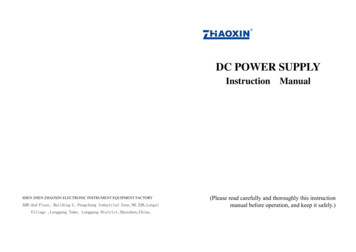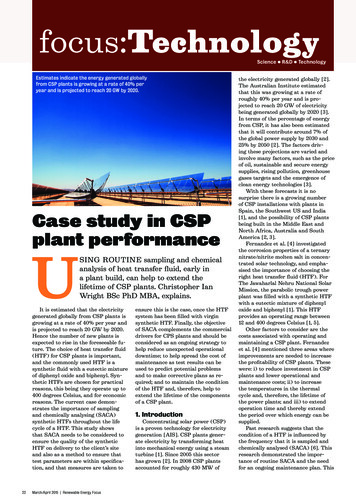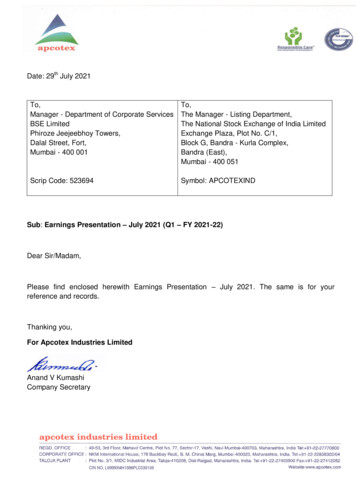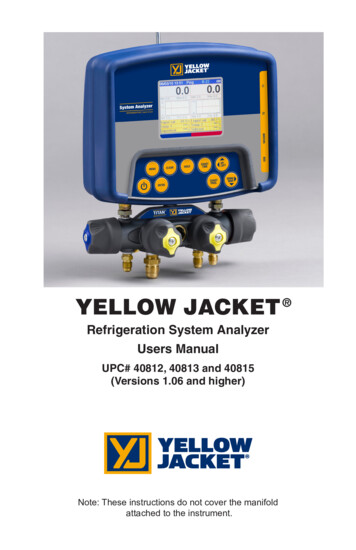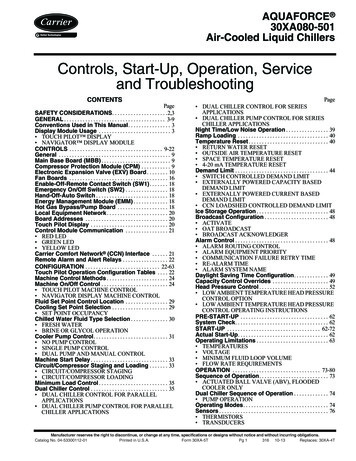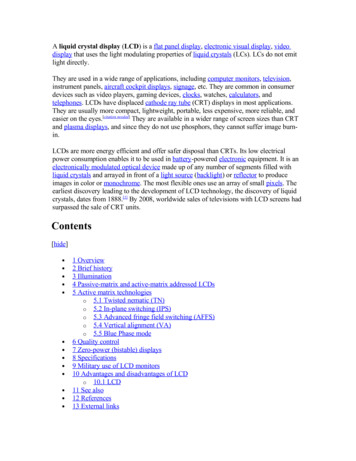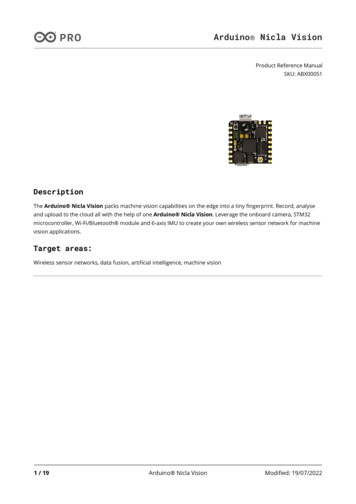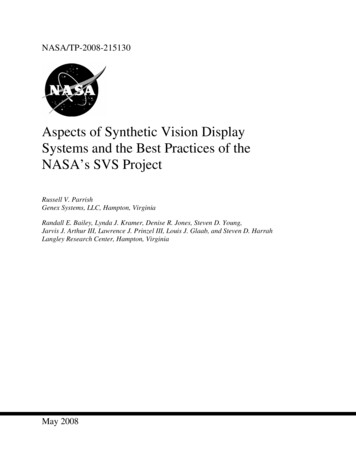
Transcription
NASA/TP-2008-215130Aspects of Synthetic Vision DisplaySystems and the Best Practices of theNASA’s SVS ProjectRussell V. ParrishGenex Systems, LLC, Hampton, VirginiaRandall E. Bailey, Lynda J. Kramer, Denise R. Jones, Steven D. Young,Jarvis J. Arthur III, Lawrence J. Prinzel III, Louis J. Glaab, and Steven D. HarrahLangley Research Center, Hampton, VirginiaMay 2008
The NASA STI Program Office . . . in ProfileSince its founding, NASA has been dedicated to theadvancement of aeronautics and space science. TheNASA Scientific and Technical Information (STI)Program Office plays a key part in helping NASAmaintain this important role.The NASA STI Program Office is operated byLangley Research Center, the lead center for NASA’sscientific and technical information. The NASA STIProgram Office provides access to the NASA STIDatabase, the largest collection of aeronautical andspace science STI in the world. The Program Office isalso NASA’s institutional mechanism fordisseminating the results of its research anddevelopment activities. These results are published byNASA in the NASA STI Report Series, whichincludes the following report types: TECHNICAL PUBLICATION. Reports ofcompleted research or a major significant phaseof research that present the results of NASAprograms and include extensive data ortheoretical analysis. Includes compilations ofsignificant scientific and technical data andinformation deemed to be of continuingreference value. NASA counterpart of peerreviewed formal professional papers, but havingless stringent limitations on manuscript lengthand extent of graphic presentations.TECHNICAL MEMORANDUM. Scientificand technical findings that are preliminary or ofspecialized interest, e.g., quick release reports,working papers, and bibliographies that containminimal annotation. Does not contain extensiveanalysis.CONTRACTOR REPORT. Scientific andtechnical findings by NASA-sponsoredcontractors and grantees. CONFERENCE PUBLICATION. Collectedpapers from scientific and technicalconferences, symposia, seminars, or othermeetings sponsored or co-sponsored by NASA. SPECIAL PUBLICATION. Scientific,technical, or historical information from NASAprograms, projects, and missions, oftenconcerned with subjects having substantialpublic interest. TECHNICAL TRANSLATION. Englishlanguage translations of foreign scientific andtechnical material pertinent to NASA’s mission.Specialized services that complement the STIProgram Office’s diverse offerings include creatingcustom thesauri, building customized databases,organizing and publishing research results . evenproviding videos.For more information about the NASA STI ProgramOffice, see the following: Access the NASA STI Program Home Page athttp://www.sti.nasa.gov E-mail your question via the Internet tohelp@sti.nasa.gov Fax your question to the NASA STI Help Deskat (301) 621-0134 Phone the NASA STI Help Desk at(301) 621-0390 Write to:NASA STI Help DeskNASA Center for AeroSpace Information7115 Standard DriveHanover, MD 21076-1320
NASA/TP-2008-215130Aspects of Synthetic Vision DisplaySystems and the Best Practices of theNASA’s SVS ProjectRussell V. ParrishGenex Systems, LLC, Hampton, VirginiaRandall E. Bailey, Lynda J. Kramer, Denise R. Jones, Steven D. Young,Jarvis J. Arthur III, Lawrence J. Prinzel III, Louis J. Glaab, and Steven D. HarrahLangley Research Center, Hampton, VirginiaNational Aeronautics andSpace AdministrationLangley Research CenterHampton, Virginia 23681-2199May 2008
Trade names and trademarks are used in this report for identification only. Their usage does notconstitute an official endorsement, either expressed or implied, by the National Aeronautics and SpaceAdministration.Available from:NASA Center for AeroSpace Information (CASI)7115 Standard DriveHanover, MD 21076-1320(301) 621-0390National Technical Information Service (NTIS)5285 Port Royal RoadSpringfield, VA 22161-2171(703) 605-6000
AbstractNASA’s Synthetic Vision Systems (SVS) Project conducted research aimed ateliminating visibility-induced errors and low visibility conditions as causal factors in civilaircraft accidents while enabling the operational benefits of clear day flight operationsregardless of actual outside visibility. SVS takes advantage of many enablingtechnologies to achieve this capability including, for example, the Global PositioningSystem (GPS), data links, radar, imaging sensors, geospatial databases, advanced displaymedia and three dimensional video graphics processors. Integration of these technologiesto achieve the SVS concept provides pilots with high-integrity information that improvessituational awareness with respect to terrain, obstacles, traffic, and flight path. This paperattempts to emphasize the system aspects of SVS - true systems, rather than just terrainon a flight display - and to document from an historical viewpoint many of the bestpractices that evolved during the SVS Project from the perspective of some of the NASAresearchers most heavily involved in its execution. The Integrated SVS Concepts areenvisagements of what production-grade Synthetic Vision systems might, or perhapsshould be in order to provide the desired functional capabilities that eliminate lowvisibility as a causal factor to accidents and enable clear-day operational benefitsregardless of visibility conditions.iii
Abbreviations and DMEDTEDEADIEBGEBGFNEFBEFISEFVSAir Data Attitude Heading Reference SystemAutomatic Direction FinderAutomatic Dependent Surveillance BroadcastAerospace & Electronic Systems SocietyAdvisory Group for Aerospace Research and DevelopmentAbove Ground LevelAmerican Institute of Aeronautics and AstronauticsAirport Movement Area Safety SystemAircraft Owners and Pilots AssociationAmes Research CenterAirborne Research Integrated Experiment SystemAerospace Recommended PracticeAirport Surface Detection EquipmentAir Traffic ControlAirport surface Target IDentification SystemAirport designator for Asheville, NCAviation Safety ProgramCollision AvoidanceCommercial transports And Business jetsCivil Aeronautical Medical InstituteCategoryConstant Color Fish-NetCandela / square meterCourse Deviation IndicatorCockpit Display of Traffic InformationCircular Error ProbabilityControlled Flight Into TerrainComputer Generated ImageConsolidated Information Technology ServicesController-Pilot Data Link CommunicationsCooperative Research AgreementCathode Ray TubeDigital Elevation ModelAirport designator for Dallas/Fort Worth International Airport, TXDifferential Global Positioning SystemDatabase Integrity Monitoring EquipmentDownward-Looking Radar AltimeterDistance Measuring EquipmentDigital Terrain Elevation DataElectronic Attitude-Direction IndicatorElevation-Based GenericElevation-Based Generic Fish-NetElectronic Flight BagElectronic Flight Information SystemEnhanced Flight Vision Systemiv
V AUAirport Designation for Eagle County Airport, COElectronic Moving MapEye Reference PointEnhanced Vision SystemFederal Aviation AdministrationFederal Aviation RegulationForward-Looking Autonomous Integrity MonitoringForward-Looking Infra-RedFlight Management DisplaysFlight Management SystemField Of ViewFlight Technical Errorfoot LambertsGeneral AviationGround CollisionGiga HertzGlobal Navigation Satellite System Landing SystemGlobal Navigation Satellite SystemGlobal Positioning SystemGPS Bi-static RadarHorizontal Field of ViewHead-Down DisplayHazardously Misleading InformationHazardous Misleading Terrain InformationHorizontal Situation IndicatorHigh Speed Civil TransportHigh-Speed ResearchHead-Up DisplayHertzInternational Civil Aviation OrganizationInstitute of Electrical and Electronics EngineersIntegrated Intelligent Flight Deck TechnologiesInstrument Landing SystemInstrument Meteorological ConditionsInchesInertial Navigation SystemInertial Reference SystemInertial Reference UnitSociety for Imaging Science and TechnologyLangley Research CenterLocal Area Augmentation SystemLiquid Crystal DisplayLinear Error ProbabilityLight Detection And RangingLOng RAnge NavigationLow-Visibility induced Aircraft Upsetv
SPSELow Visibility Landing and Surface OperationsLow Visibility Loss Of ControlMinimum Aviation System Performance StandardsMinification FactorMilliMeter Wave RadarMinimum Operational Performance StandardsMean Sea LevelNational Airspace SystemNational Aeronautics and Space AdministrationNorth Atlantic Treaty OrganizationNavigationNavigation DisplayNon-Directional BeaconNautical MilesNOtice To AirMenNational Transportation Safety BoardOut The WindowPersonal ComputerPilot FlyingPrimary Flight DisplayPrimary Flight ReferenceAirport Designation for Newport News/Williamsburg InternationalAirport, VAPilot Not FlyingReceiver Autonomous Integrity MonitorRunway Conflict AlertRunway Incursion Advisory and Alerting System (now known asPathProx )Runway Incursion Prevention SystemRoot Mean SquareArea NavigationAirport designator for Reno/Tahoe International Airport, NVRequired Navigation PerformanceAirport designator for Roanoke Regional Airport, VARollOut / Turn-OffRunway Safety MonitorRunway Traffic AlertRadio Technical Commission for AeronauticsRejected Take-OffSituation AwarenessSociety of Automotive EngineersSmall Business Innovation ResearchSHadow Detection and ExtractionSurface Operations Research and Evaluation VehicleInternational Society for Optical EngineeringSociety of Photographic Scientists and Engineersvi
FRVHFVMCVORVSDWAASWALWGS84WOWWxWxRXVSSpace Shuttle Radar Topography MissionSynthetic VisionSynthetic Vision Auxiliary DisplaySynthetic Vision Display ConceptsSynthetic Vision SystemTerrain Awareness and Warning SystemTraffic alert and Collision Avoidance SystemTraffic Information Services - BroadcastTaxiway Navigation And Situation Awareness systemTake-Off / Go-AroundUnited States Air ForceUniversal Transverse MercatorVertical Field of ViewVisual Flight RulesVery High FrequencyVisual Meteorological ConditionsVHF Omnidirectional Range navigation systemVertical Situation DisplayWide Area Augmentation SystemAirport designator for Wallops Flight Facility, VAWorld Geodetic System 1984Weight-On-WheelsWeatherWeather RadareXternal Visibility Systemvii
Table of ContentsAbstract .iiiAbbreviations and Acronyms . ivList of Tables .xList of Figures . xiExecutive Summary . 11.Introduction. 22.Background . 83.Synthetic Vision Systems . 123.1System Aspects for Commercial Transports / Business Jets . 123.1.1Operational Uses in IMC . 133.1.2HUD / Enhanced Vision Imaging Sensor Considerations . 153.1.3The Integrated SVS Concept . 183.2System Aspects for General Aviation Aircraft . 323.2.1GA Operations (Off-Nominal VMC, Nominal IMC, Off-Nominal IMC,Enhanced) . 343.2.2The Integrated GA SVS Concept. 364.SVS Benefits. 404.1Commercial Transports / Business Jets . 414.1.1Safety Benefits . 424.1.2Operational Benefits . 434.2General Aviation. 454.2.1Safety Benefits . 454.2.2Operational Benefits . 475.Applications & Intended Function by Phases of Flight . 475.1Commercial Transports / Business Jets . 475.1.1Take-off. 485.1.2Departure. 485.1.3En route. 495.1.4Approach. 495.1.5Landing / Flare / Touchdown. 495.1.6Go-Around . 505.1.7Rollout / Turn-off. 505.1.8Surface Operations. 515.2General Aviation. 515.2.1Take-off. 525.2.2Cruise . 525.2.3Landing . 535.2.4Go-Around . 545.2.5Surface Operations. 546.SVS Best Practices. 546.1Commercial Transports / Business Jets . 556.1.1Database. 556.1.2Flight Operations Displays . 646.1.3Surface Operations Displays. 926.1.4Runway Incursion Prevention System . 99viii
6.1.5EVS Imagery. 1016.1.6Database Integrity Monitoring. 1046.1.7Hazard Detection Sensors . 1106.1.8The Integrated SVS Concept . 1136.2General Aviation. 1136.2.1Display Considerations . 1136.2.2Database Depiction . 1136.2.3Flight Operations Considerations . 1156.2.4Surface Operations Considerations. 1226.2.5Runway Incursion Prevention System . 1226.2.6Database Integrity Monitoring. 1267.Concluding Remarks. 1268.References. 128ix
List of TablesTable 1. Flight tests under direct NASA control. . 7Table 2. Functions and technologies involved in the Integrated SVS System . 20Table 3. Display size and available fields of view and Minification Factors (MFs) forevaluation. 82x
List of FiguresFigure 1. Synthetic Vision System. 2Figure 2. Example of SVS primary flight display and navigation display. . 5Figure 3. Early raster graphic presentation of an airport scene on a large screenpanoramic display. 10Figure 4. Percentage of world jet transport aircraft cockpit display equipage. . 16Figure 5. The Synthetic Vision HUD Concept. . 16Figure 6. Block diagram of Integrated SVS Concept for CAB aircraft with glasscockpits. 19Figure 7. Image of Size-A display for 30 º FOV with photo-textured terrain, illustrating adial format. . 22Figure 8. Image of Size-D display for 30 º FOV with photo-textured terrain, illustrating atape format. 22Figure 9. Conventional exocentric coplanar navigation display with TAWS. . 23Figure 10. SVS coplanar navigation display with TAWS overlays. . 23Figure 11. Selectable 2-D coplanar and 3-D “situation awareness” (perspective view)modes of SVS navigation display. . 24Figure 12. Rehearsal tool mode using SVS ND “situation awareness” format. 25Figure 13. SVS primary flight display and coplanar navigation display withneighborhood traffic and ground obstacles. 26Figure 14. Illustration of RIPS HUD landing/rollout deceleration guidance format (allHUD symbology is monochrome green). . 27Figure 15. Illustration of RIPS HUD turn guidance format using non-conformal taxidirector symbology (all HUD symbology is monochrome green). 27Figure 16. RIPS Electronic Moving Map (EMM). . 28Figure 17. RIPS runway conflict alert on SVS HUD, PFD, and EMM displays. 29Figure 18. Database Integrity Monitoring Equipment. 30Figure 19. The wire-frame display element of the SVS PFD. . 33Figure 20. Block diagram of Basic SVS Concept for GA aircraft. 36Figure 21. Block diagram of Enhanced SVS Concept for GA aircraft. 37Figure 22. The GA Basic SVS PFD. 39Figure 23. The GA Basic SVS ND on approach to ROA. 39Figure 24. Round off effect of lower terrain resolution. 57Figure 25. RTCA-276 terrain and obstacle database requirements overview. . 57Figure 26. Elevation-based color-coding with generic texturing (EBG) and photorealistic texturing of a Juno, AK DEM. . 58Figure 27. EGE flight activities aboard the NASA ARIES. . 60Figure 28. The hybrid texturing method applied to the RNO database. . 61Figure 29. Fish-net grids embedded within into generic-textured and photo-realistictextured databases of ROA. . 62Figure 30. Views of the EGE airport property before and after bull-dozing and insertingpolygon models of the runway and airport buildings. . 63Figure 31. HUD tunnel used at RNO and WAL flight trials. . 67Figure 32. The HDD minimal tunnel concept used at the EGE flight trials. 67Figure 33. The dynamic tunnel concept with some error. . 68Figure 34. Outside the dynamic tunnel concept. 69xi
Figure 35.Figure 36.Figure 37.Figure 38.Figure 39.Figure 40.Figure 41.Figure 42.Figure 43.Figure 44.Figure 45.Figure 46.Figure 47.Figure 48.Figure 49.Figure 50.Figure 51.Figure 52.Figure 53.Figure 54.Figure 55.Figure 56.Figure 57.Figure 58.Figure 59.Figure 60.Figure 61.Figure 62.Figure 63.Figure 64.Four tunnel color choices; Magenta, Green, White, Black. . 70Seven tunnel and halo thickness choices. 71EGE RMS lateral and vertical path error over the entire approach path. 72Guidance symbols: Integrated cue “Ball” (left), “Tadpole” (center) and Ghostaircraft (two perspectives, at right). . 73An SVS PFD showing neighborhood traffic. . 75GA PFD with horizon line gapped about the velocity vector symbol. 76The coplanar view of the SVS ND during RNP procedures. . 77An example of a periphery symbology set for EVS imagery presentation onthe SV-AD, by CRA partner CMC Electronics, Inc. 79Definition of a conformal display’s horizontal and vertical FOVs, along withthe aspect ratio. . 79Image of ARINC Size-D display for 30º FOV, approximately 1.5 nm from aDFW runway. 80Image of ARINC Size-D display for 60º FOV for identical aircraft position,approximately 1.5 nm from a DFW runway. 80DFW change of runway task. . 82MF used in DFW change of runway transition task as function of the SVSHDD size. 83MF used in DFW landing task as function of the SVS HDD size. . 83Ease in determining aircraft position with respect to terrain with SVSconcepts compared to baseline EADI with TAWS display configuration. . 84Effect of changing the attitude angle of the light source from 45º to 67º in thedatabase image renderer. 88SA-SWORD results from EGE flight test comparing statisticallydiscriminable SVS display concepts against baseline EADI with TAWSdisplay configuration. . 89The dynamic “situation awareness” mode of the SVS ND. . 90Illustration of RIPS HUD symbology set for landing (all HUD symbology ismonochrome green). . 93Illustration of RIPS HUD symbology set for rollout (all HUD symbology ismonochrome green). . 94RIPS HUD taxi operations format, including non-conformal taxi directorsymbology. 95Illustration of RIPS HUD symbology set for take-off (all HUD symbology ismonochrome green). . 95Runway closed symbology. 96RIPS overhead view of airport surface. 97RIPS system overview. 100RNO and WAL flight activities aboard the Gulfstream G-V. 103The SHADE algorithm. . 106Weather radar shadow diagram. . 107Segment of sample radial measurement and shadow edge features fromweather radar data. . 107SHADE results for three sample scans from DC-8 testing (a) WxR-derivedthread, (b) DEM-derived thread. 109xii
Figure 65. The GPS Bi-static Radar (GPSBR) receiver utilizes GPS signals reflectedfrom terrain. . 110Figure 66. NASA LaRC’s Cessna 206-H Stationaire. 114Figure 67. GA conventional baseline round dial (BRD) display concept. . 115Figure 68. GA constant color ground with a fish-net (CCFN) display concept. . 116Figure 69. GA elevation based generic (EBG) SVS display concept. 116Figure 70. GA elevation based generic with a fish-net (EBGFN) SVS display concept. 117Figure 71. GA photo-realistic SVS display concept. 117Figure 72. GA photo-realistic with a fish-net SVS display concept. 118Figure 73. GA pitch / roll dual cue (needles) flight director display concept. . 119Figure 74. GA RMS lateral and vertical tracking error results. 119Figure 75. GA pitch / roll single cue flight director display concept. . 120Figure 76. GA Unconnected Box Tunnel display concept. . 120Figure 77. GA Connected Box Tunnel with Sliding Box Guidance Cue displayconcept. . 121Figure 78. GA Crow’s Foot Tunnel with Ghost Aircraft display concept. 121Figure 79. GA ND with TAWS implemented on an Mx-20 (on approach to ROA). 123Figure 80. GA version on approach to RNO adapted from the CAB ND withneighborhood traffic and TAWS overlays (not shown). 123Figure 81. Runway Incursion Rates from FAA Runway Safety Report, August, 2004.124Figure 82. Runway Incursion by Severity Category from FAA Runway Safety Report,July, 2003. 125Figure 83. GA RIPS overhead view of airport surface. 125xiii
Executive SummaryWithin the National Aeronautics and Space Administration (NASA) Aviation SafetyProgram (AvSP), the Synthetic Vision Systems Project has developed aircraft cockpitdisplay system concepts to improve pilot awareness of the external environment byproviding a perspective computer-generated view of the outside world. This syntheticview of the external environment is created by the use of on-board geospatial databasesand precise aircraft attitude and positioning information computed by a GlobalPositioning System-based navigation system. This work was aimed at eliminatingvisibility-induced errors and low visibility conditions as causal factors in civil aircraftaccidents while enabling the operational benefits of clear day flight operations regardlessof the actual outside visibility condition. To meet all of these goals, Synthetic Vision(SV) must provide more than just a display of terrain information. In that regard, aSynthetic Vision System (SVS) takes advantage of many enabling technologies that,together, create an operational avionics system, including the display of the externalenvironment, with independent, redundant information sources to enable substantiallyimproved performance and enhanced operational capabilities. The independentinformational elements form the basis for monitoring the dynamic
Systems and the Best Practices of the NASA's SVS Project Russell V. Parrish Genex Systems, LLC, Hampton, Virginia . Phone the NASA STI Help Desk at (301) 621-0390 Write to: NASA STI Help Desk NASA Center for AeroSpace Information 7115 Standard Drive Hanover, MD 21076-1320.

